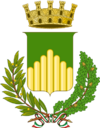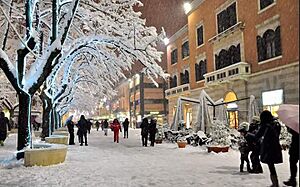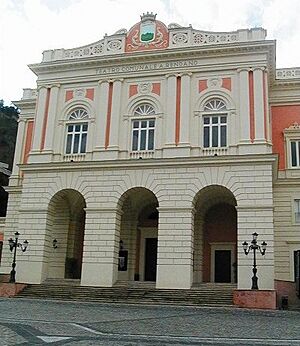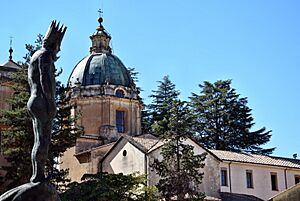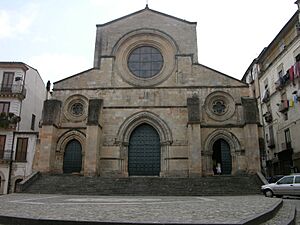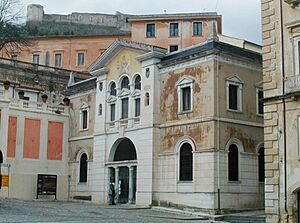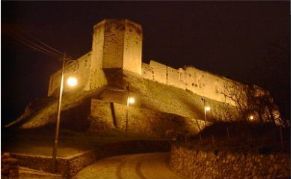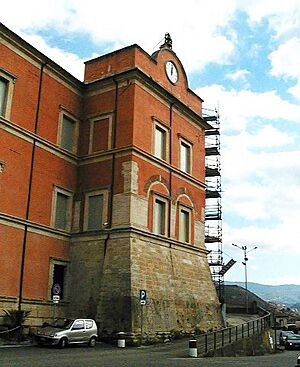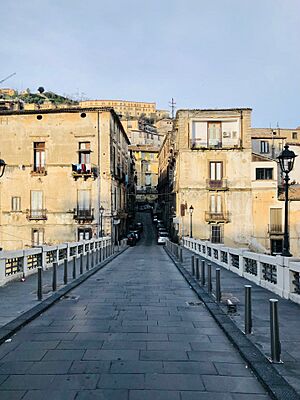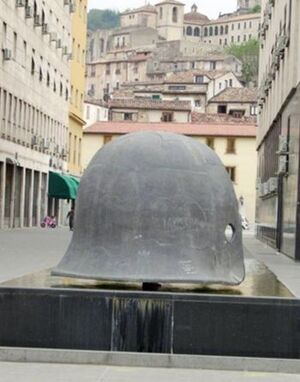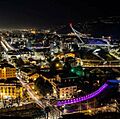Cosenza facts for kids
Quick facts for kids
Cosenza
|
||
|---|---|---|
| Città di Cosenza | ||
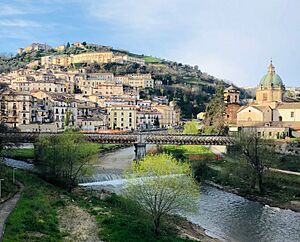
View of the old town
|
||
|
||
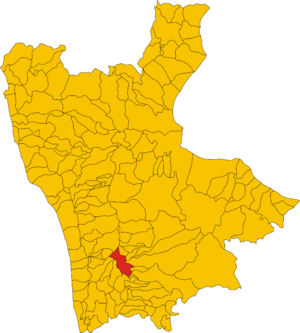
Cosenza within the province of Cosenza
|
||
| Country | Italy | |
| Region | Calabria | |
| Province | Cosenza (CS) | |
| Frazioni | Donnici, Sant'Ippolito, Borgo Partenope, Muoio | |
| Area | ||
| • Total | 37 km2 (14 sq mi) | |
| Elevation | 238 m (781 ft) | |
| Population
(28 December 2020)
|
||
| • Total | 67,563 | |
| • Density | 1,826/km2 (4,730/sq mi) | |
| Demonym(s) | Cosentians (Italian: cosentini) | |
| Time zone | UTC+1 (CET) | |
| • Summer (DST) | UTC+2 (CEST) | |
| Postal code |
87100
|
|
| Dialing code | 0984 | |
| Patron saint | Our Lady of the Pillar | |
| Saint day | 12 February | |
Cosenza is a city in Calabria, Italy. About 70,000 people live in the city center. More than 200,000 live in the wider urban area. It is the capital of the province of Cosenza, which has over 700,000 residents. People from Cosenza are called Cosentians.
Cosenza is home to the Cosentian Academy. This is one of the oldest schools for philosophy and literature in Italy and Europe. Today, Cosenza is still a cultural center. It has many museums, monuments, theaters, and libraries. The modern city is part of a larger urban area. This area includes the town of Rende, where the University of Calabria is located.
Contents
Discovering Cosenza's Location
Cosenza is located where two historic rivers meet: the Busento and the Crati. The city sits 238 meters (about 780 feet) above sea level. It is in a valley between the Sila mountains and the coastal mountains.
The old part of the city is overshadowed by its Swabian castle. It goes down towards the Crati river. The newer part of the city is to the north, across the Busento river, on flat land. Cosenza is almost completely surrounded by mountains. This gives it a special climate. It has cold winters and hot summers, not much affected by the Mediterranean Sea.
A Journey Through Cosenza's History
Ancient Beginnings
The ancient city of Consentia was the capital of the Brettii tribe. It was a strong defense for the Italic people against the Greek influences from nearby colonies. A famous battle, the Battle of Pandosia, happened in this area. A small Italic army defeated Alexander of Epirus, who was the uncle of Alexander the Great. Cosenza always kept its unique character among the cities in the region.
Under Emperor Augustus, Cosenza became an important stop on the Roman road called via Popilia. This road connected Calabria to Sicily. During the Roman Empire, the town had special rights as a municipality.
The Legend of Alaric's Tomb
In 410 AD, Alaric I, the king of the Visigoths, attacked and captured Rome. He was the first foreign enemy to take the city in over 800 years. Alaric collected a huge amount of treasure from Rome.
According to the historian Jordanes, Alaric went south with his troops after sacking Rome. He easily moved forward until he reached the Cosenza area, where he died. No one knows for sure how he died. Some think he got sick, while others believe he was attacked by enemies.
His soldiers wanted to honor their king. They buried him in a special tomb in Cosenza. It is said that his burial place was where the Busento and Crathis rivers meet. Slaves were used to change the river's path. This allowed them to dig a tomb big enough for Alaric, his horse, and all his treasure. Once the tomb was finished, the river was put back into its original bed. This covered the tomb with water. To make sure no one would ever tell where the tomb was, Alaric's soldiers killed all the slaves.
After the Western Roman Empire fell, some towns in Cosenza province, like Rossano, did not accept the new rulers. They had strong city walls and small Roman armies. They managed to stay semi-independent for centuries.
Norman, Hohenstaufen, and Angevin Times
Cosenza was often fought over by the Saracens and the Lombards. The town was destroyed and then rebuilt around 988. But it was ruined again in the early 11th century. To escape the destruction, people left the town. They found shelter on the hills nearby and built small villages, which are still called casali.
By the mid-11th century, Lombard Calabria became a feudal dukedom under the Normans. Cosenza was its capital. The town soon rebelled against Roger Guiscard. It was only recaptured after a long siege. Later, under the Hohenstaufen rulers, Cosenza became the seat of the Court of Calabria (Curia Generale). Emperor Frederick II was very interested in the town. He encouraged building and business. He also started an important yearly fair.
After this, Cosenza fought hard against the Angevin rulers. The clergy supported this fight. The uprising spread through the Crathis valley. Cosenza was caught in the back-and-forth struggle between the Angevins and the Crown of Aragon. In 1432, King Louis III of Anjou lived in Cosenza's castle with his wife Margaret of Savoy. He died unexpectedly in 1434 and was buried in the cathedral.
Spanish Rule and Modern Age
In 1500, Cosenza was taken by the Spanish army. This happened despite resistance led by Captain Gonzalo Fernández de Córdoba. During the 16th century, the town grew as the seat of the Viceroy of Calabria. Its cultural importance also increased. This was thanks to the founding of the Accademia Cosentina. Famous members included Bernardino Telesio and Antonio Serra.
In 1707, the Austrians took over from the Spanish in the Kingdom of Naples. Then came the Bourbons. After a short-lived Parthenopean Republic in 1799, the town was finally taken for the Bourbons. This was done by Cardinal Fabrizio Ruffo's Lazzari. Cardinal Ruffo was from the Cosenza province.
From 1806 to 1815, Cosentians fought against French rule. This time was marked by harsh punishments. Cosenza became a center for the Carbonari secret societies. In 1813, many rebels were executed in the town. Local riots in 1821 and 1837 led to the Risorgimento, which was the movement for Italian unification. A big uprising happened on March 15, 1844. It ended with the execution of the Bandiera Brothers and their followers in Cosenza. In 1860, after Giuseppe Garibaldi's quick and heroic actions, Calabria joined the new Kingdom of Italy.
Cosenza's Population Over Time
| Historical population | |||||||||||||||||||||||||||||||||||||||||||||||||||||||
|---|---|---|---|---|---|---|---|---|---|---|---|---|---|---|---|---|---|---|---|---|---|---|---|---|---|---|---|---|---|---|---|---|---|---|---|---|---|---|---|---|---|---|---|---|---|---|---|---|---|---|---|---|---|---|---|
|
|
||||||||||||||||||||||||||||||||||||||||||||||||||||||
| Source: ISTAT | |||||||||||||||||||||||||||||||||||||||||||||||||||||||
Main Sights to Explore
Church of San Domenico
The Church of San Domenico was founded in 1448. It mixes Medieval and Renaissance styles. Its most interesting part is the rose window. This window has 16 small tuff columns. The wooden door from 1614 has carved flowers, saints, and coats of arms.
Inside, you can see art by Antonio Granata. This includes a painting of the Madonna of the Rosary. The main altar is made of colorful marble. The sacristy has a special ribbed ceiling and a double window.
The Cathedral
The exact start of the Duomo (Cathedral of Santa Maria Assunta) is unknown. It was likely built in the early 11th century. An earthquake destroyed it in 1184. Rebuilding finished by 1222. Emperor Frederick II then consecrated it.
In the 18th century, the church was covered in Baroque style. This hid its original look and art. In the 19th century, the front was changed to Neo-Gothic. Later, Archbishop Camillo Sorgente began restoring it. He brought back the old arches and structure. The work was finished in the 1940s.
The tomb of Isabella of Aragon is in the transept. She was the wife of King Philip III of France. A long walkway connects the Duomo to the archbishop's palace. This palace has a painting by Luca Giordano. You can also see a rare and valuable Stauroteca. This is a relic that holds pieces of wood from Christ's cross. It was a gift from Emperor Frederick II when the Duomo was consecrated.
Monastero delle Vergini
The "Convent of the Virgins" is on via Gaetano Argento. The main entrance has decorated tuff on the outside. The inside is carved wood. The convent holds a 16th-century painting of the Annunciation. In front of it is the 13th-century Madonna del Pilerio. On the walls are four other 16th-century paintings. The main altar has a painting called Transit of the Virgin from 1570. The wooden choir dates back to the 17th century.
Giostra Vecchia
The Renaissance style came to Cosenza at the Giostra Vecchia in the 15th century. Here, you will find the church and monastery of Saint Francis of Assisi. The church has a main nave and two side aisles. The impressive high wooden altar was built in 1700. Above it is a painting by Daniele Russo. The left aisle has a 17th-century wooden crucifix. It also has a marble statue of the Madonna with Child from the 16th century. The sacristy has a painted wooden ceiling. It also has a wooden cabinet showing scenes from the Passion of Christ.
Hohenstaufen Castle
The Castello Svevo (Hohenstaufen Castle) was first built by the Saracens around the year 1000. It was built on the ruins of an old fort. Emperor Frederick II restored the castle in 1239. He added an octagonal tower. It is said that his son Henry was held prisoner here by his father. Louis III of Naples and Margaret of Savoy were married in the castle. They lived there in 1432.
Today, there are no signs left of the old Saracen structure. Inside the courtyard, you can see changes made by the Bourbons. They turned it into a prison. The entrance hall has pointed arches with carved brackets. A wide hallway has fleur-de-lis symbols from the House of Anjou coat of arms. These are carved on the Hohenstaufen arches.
Spirito Santo
The church of Sant'Agostino, also known as the Spirito Santo, was built in 1507. The original entrance has old Gothic writings. Inside, there are paintings from the 18th century. A narrow street nearby leads to the “Area of the Bandiera Brothers”. This place is called the Vallone di Rovito. Here, the rebel patriots from 1844 were executed by a firing squad.
San Francesco di Paola
In the Arenella area, you'll find the church and monastery of Saint Francis of Paola (1510). The inside has one main nave. It holds the tomb of Ottavio Cesare Gaeta. On the right wall are two 18th-century paintings. One is a Sacra Famiglia, and the other is Madonna con San Francesco e Sant’Agostino. On an altar is a wooden statue of Saint Francis of Paola. On the left side, there is a wooden statue of San Michele Arcangelo. The painting Madonna with Child in Glory and Saints Paul and Luke (1551) was done by Pietro Negroni.
San Salvatore
The small church of San Salvatore serves the parish that follows the Byzantine-Albanian faith. Inside, the nave has a wooden ceiling. There are also frescoes of the Apostoli, the Salvatore, and the Madonna. A beautiful iconostasis is also present.
Open Air Museum
In the modern part of Cosenza, there is an open-air museum called "Museo MAB" (Museo all'aperto Bilotti). It stretches from Corso Mazzini to Piazza Bilotti. This museum has many modern art sculptures placed right on the street. Residents and tourists can enjoy them. The sculptures were given to the city by Carlo Bilotti, an Italian-American art collector. They include Saint George and the Dragon by Salvador Dalí and Hector and Andromache by Giorgio de Chirico. You can also see "the Bronzes" by Sacha Sosno and The Bather by Emilio Greco.
Museums and Cultural Places
Cosenza has many places for learning and culture:
- National Gallery - Palazzo Arnone
- Civic Archeological Museum
- Remembrance Museum
- Bilotti Open Air Museum
- Rendano Theatre
- Morelli Theatre
- Acquario Theatre
- Cosentian Academy
- University of Calabria
- Music Conservatoire
- State Archive Library
- Civic Library
- National Library
- District Library
- Children's Library
- Antonio Guarasci Foundation Library
- Calabria Jazz Centre Recordings Archive
- Theological Library (Seminario Cosentino)
- Cultural and Ethno-Anthropological Heritage Archive
Sports in Cosenza
Cosenza is home to Cosenza Calcio, a football team that plays in Serie B.
Events and Festivals
Cosenza hosts several fun events and festivals:
- Fiera di S.Giuseppe - March
- Festival delle Invasioni - July
- Festa del Cioccolato (Chocolate Festival) - October
- La sagra dell'uva e del vino (Wine Festival) in Donnici - October
Famous People from Cosenza
Many notable people have come from Cosenza:
- Joachim of Fiore (theologian, c.1135-1202)
- Aulo Giano Parrasio (humanist, 1470–1521)
- Bernardino Telesio (philosopher, 1509–1588)
- Pietro Negroni (painter, 1505–1565)
- Antonio Serra (economist, late 1500s)
- Sertorio Quattromani (philosopher, 1541–1607)
- Niccolò Pasquali (musician, 1717/18–1757)
- Francesco Saverio Salfi (writer, 1759–1832)
- Nicola Misasi (writer, 1850–1923)
- Alfonso Rendano (pianist, 1853–1931)
- Alessandro Longo (composer, 1864–1945)
- Pietro Mancini (politician, 1876–1968)
- Fausto Gullo (politician, 1887–1974)
- Stefano Rodotà (politician, 1933-2017)
- Sandra Savaglio (astrophysicist, born 1967)
- Maria Perrotta (pianist, born 1974)
- Stefano Fiore (footballer, born 1975)
- Maria Perrusi (Miss Italia 2009)
Cosenza's International Connections
Cosenza has sister cities around the world:
 Kenosha, Wisconsin, United States, since 1979
Kenosha, Wisconsin, United States, since 1979 Lansing, Michigan, United States, since 2000
Lansing, Michigan, United States, since 2000 Sault Ste. Marie, Ontario, Canada, since 2010
Sault Ste. Marie, Ontario, Canada, since 2010
Images for kids
See also
 In Spanish: Cosenza para niños
In Spanish: Cosenza para niños


